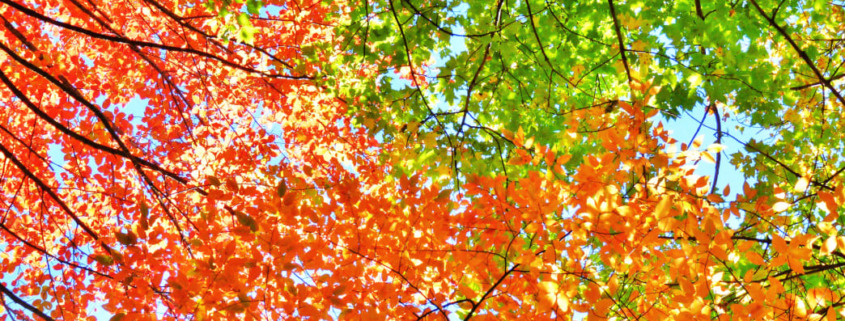Autumn is that seasonal sweet spot between the balmy, bug-bitten days of summer and the frigid frost of winter, a time when fiery foliage makes outdoor excursions even more alluring. While leaf-peepers from all over the East Coast flock to the mountains, forests, and waterways of North Carolina, some of the state’s most stunning natural spaces remain nearly devoid of visitors. This fall, soak up North Carolina’s stunning seasonal color in the state’s overlooked wild places.
1. Medoc Mountain State Park

bobistraveling
Just outside the town of Hollister, Medoc Mountain State Park is an inviting but inexplicably often ignored autumn retreat. Laced with 10-miles of hiking trails, the park offers everything from gentle, streamside rambles to more rugged loops over the park’s rocky bluffs. Take to the placid waters of Fishing Creek or bring a picnic and set up shop for the day in the midst of the park’s sprawling, fall-color-tinged meadow.
2. Falls Lake State Recreation Area

Razvan Orendovici
Enjoy autumn colors at one of the state’s most unique outdoor spaces, Falls Lake State Recreation Area in Wake Forest. A veritable paddler’s paradise, the recreation area actually consists of a series of access sites dotting the forest-fringed fingers of a massive 12,000-acre reservoir. Beyond the water, many of the access points also feature campsites, mountain biking trails and hiking trails, including an extensive segment of the Mountain-to-Sea Trail, which hugs the lake’s southern shore.
3. Middle Prong Wilderness

Joe Giordano
Tucked away in the massive Pisgah National Forest, the Middle Prong Wilderness is one of the vast recreation area’s most rugged and least-visited corners. The 7,900-acre wilderness located near Asheville is loaded with challenging terrain dominated by high peaks, precipitous drop-offs, and craggy ridgelines. For real solitude seekers, Middle Prong Wilderness is managed to show minimal signs of human impact. While there are ample hiking options, including access to the Mountains-to-Sea Trail, signage is minimal, so plan on using those well-honed navigational skills.
4. New River State Park

bobistraveling
One of the state’s wildest parks, New River Park showcases one of North Carolina’s most stunning waterways. Distinguished as a National Scenic River four decades ago, the New River flows past some of the state’s most dramatic, mountain-loaded landscapes. The park features a handful of hiking trails, but the real highlight is the mighty river itself. The state park is also loaded with pristine backcountry retreats, offering an array of primitive hike-in and paddle-in campsites spread throughout the 750-acre recreation area.
5. South Mountain State Park

Charlie Cowins
Clinging to the Jacob Fork River, South Mountain State Park is a blissful escape for backpackers. There are 50-miles of sylvan trails, trout-loaded steams, and dispersed backcountry campsites to explore. Besides just hiking, the park also boasts 18 miles of mountain biking trails and 33 miles of bridle trails. High Shoal Falls’ tumbling, 80-foot cascade is a beautiful waterfall that is especially alluring when framed by autumn’s palette of burning colors.
6. Merchants Millpond State Park

bobistraveling
Foliage-seeking shutterbugs will relish in Merchants Millpond’s photogenic potential. The tannin-tinged backwater makes for a stunning backdrop of iconic fall portraits. Aside from just aesthetics, hikers can enjoy the state park’s 9-miles of trails while paddlers can explore Merchants Millpond from the water. For a longer getaway, the park also offers family-style campgrounds, backcountry tent sites, and even a few rustic paddle-in campsites.
7. Uwharrie National Forest

emily accipiter stewart
A little more than an hour's drive from Charlotte and Greensboro, the Uwharrie National Forest harbors seemingly untouched backcountry and some of the oldest mountains on the continent. The 51-acre national forest is also traversed by nearly 70 miles of trails, including two extensive routes perfect for color-loaded fall backpacking trips: the 10-mile Dutchman’s Creek and 20-mile Uwharrie Trail. Beyond the potential for backcountry forays, the national forest also boasts a bounty of scenic lakeside campsites at the Badin Lake Campground.
8. Alligator River National Wildlife Refuge

USFWS SE Region
Fall is still prime paddling season along North Carolina’s coast and the Alligator River National Wildlife Refuge has an abundance of options to suit any skill level. Fringed by the Alligator River and the Albemarle, Croatan, and Pamlico sounds, this wildlife refuge includes more than 15 miles of well-marked paddling trails plus plenty of terrestrial trails and bike-able public access roads. The mammoth refuge is also one of the state’s most unique wildlife areas. This sanctuary harbors more than 200 different birds, a booming black bear population, and most notably, a small population of endangered red wolves, reintroduced from captivity in the late 1980s.
9. Three Top Mountain Game Land

James Lautzenheiser
Managed by the Nature Conservancy, Three Top Mountain in the North Carolina High Country is still off the radar of many weekend warriors. Named for the three distinctive rock outcroppings dominating the protected area, Three Top Mountain is loaded with seasonal color, in large part, due to the preserve’s unique geological composition. This includes amphibolite bedrock, rarely found in regional ecosystems. The 2,308-acre preserve’s high country hiking trails still feel undiscovered and include gritty climbs to elevations of 4,800 feet above sea level.
10. Goose Creek State Park

bobistraveling
Nestled along the confluence of Goose Creek and the Pamlico River, Goose Creek State Park showcases a stunning array of coastal ecosystems, from cypress swamps to mixed hardwood forests. The park is also loaded with recreational opportunities including 8 miles of hiking trails and an abundance of recreational paddling on both Goose Creek and the Pamlico River. For a starry night away from the urban grind, pitch a tent in the park’s pine shaded campsites.
Written by Malee Baker Oot for RootsRated in partnership with Visit North Carolina .
Featured image provided by David Siu



Leave a Reply
Want to join the discussion?Feel free to contribute!